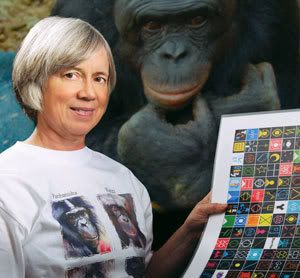From today's Des Moines Business Record:
Dr. Sue Savage-Rumbaugh is one of the first scientists on earth to study how bonobos, a species of chimpanzee, use language among themselves and other species, including humans. She conducts her seminal research for the Great Ape Trust of Iowa on a 230-acre Des Moines compound.
"They don't have the same kind of voice box humans have, so we had to develop another way for them to communicate," Savage-Rumbaugh said.
The solution she crafted is called a lexigram - a board covered with 384 symbols, each representing a word. The bonobo can speak by pointing to symbols that substitute for words he or she wants to convey. Some symbols represent actions or what can be touched or seen, like burritos, other bonobos, water, or Savage-Rumbaugh herself. But other symbols stand for moods or concepts such as "yesterday," "secret" and "pretend."
"They can now use over 400 symbols and are capable of understanding far more auditory words than that," Savage-Rumbaugh said. "They can signal that they are happy or sad."
The bonobos can form complete sentences by pointing to the symbols. When she and her former husband began their research, no one knew whether chimpanzees were capable of the linear logic required for sentences.
Savage-Rumbaugh met her husband through research. Although she and her husband have been divorced for about 10 years, they continue to work on research projects together.
"Early on in her work as a scientist, she was often met with skepticism," the renowned scientist Dr. Jane Goodall wrote in her letter nominating Savage-Rumbaugh as a Woman of Influence. "Nevertheless, she was able to overcome this."
Just like humans learning a second language, apes find it easier to learn the symbolic language when they start studying as children rather than adults.
Savage-Rumbaugh joined the Trust after 30 years with Georgia State University's Language Research Center, where she worked with eight bonobos. She brought that group with her to Iowa's Great Ape Trust. When the facility is completed, it will be the largest in North America to house bonobos, chimpanzees, gorillas and orangutans.
Savage-Rumbaugh is currently working on two books about how mother apes communicate with infants and how apes make and use tools. Goodall praised her research for showing that the tools apes fashion are very similar to those made by prehistoric humans.
"Understanding how apes acquire communication skills helps humans realize how we become what we are in terms of personality, character and ethics," Savage-Rumbaugh said.
Aug 6, 2007
Women of Influence - Sue Savage-Rumbaugh

Subscribe to:
Post Comments (Atom)

















No comments:
Post a Comment